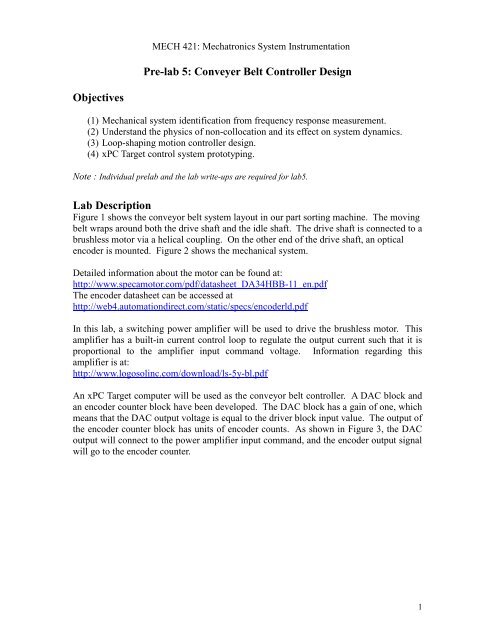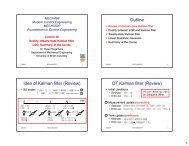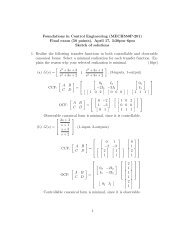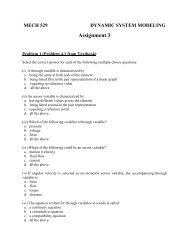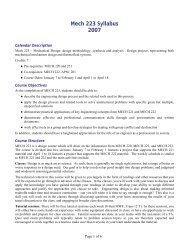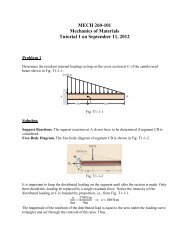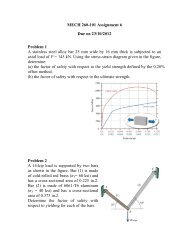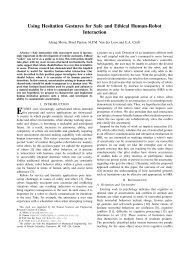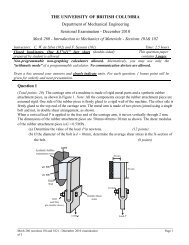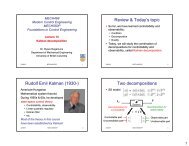Pre-lab 5 - UBC Mechanical Engineering
Pre-lab 5 - UBC Mechanical Engineering
Pre-lab 5 - UBC Mechanical Engineering
You also want an ePaper? Increase the reach of your titles
YUMPU automatically turns print PDFs into web optimized ePapers that Google loves.
MECH 421: Mechatronics System Instrumentation<br />
<strong>Pre</strong>-<strong>lab</strong> 5: Conveyer Belt Controller Design<br />
Objectives<br />
(1) <strong>Mechanical</strong> system identification from frequency response measurement.<br />
(2) Understand the physics of non-collocation and its effect on system dynamics.<br />
(3) Loop-shaping motion controller design.<br />
(4) xPC Target control system prototyping.<br />
Note : Individual pre<strong>lab</strong> and the <strong>lab</strong> write-ups are required for <strong>lab</strong>5.<br />
Lab Description<br />
Figure 1 shows the conveyor belt system layout in our part sorting machine. The moving<br />
belt wraps around both the drive shaft and the idle shaft. The drive shaft is connected to a<br />
brushless motor via a helical coupling. On the other end of the drive shaft, an optical<br />
encoder is mounted. Figure 2 shows the mechanical system.<br />
Detailed information about the motor can be found at:<br />
http://www.specamotor.com/pdf/datasheet_DA34HBB-11_en.pdf<br />
The encoder datasheet can be accessed at<br />
http://web4.automationdirect.com/static/specs/encoderld.pdf<br />
In this <strong>lab</strong>, a switching power amplifier will be used to drive the brushless motor. This<br />
amplifier has a built-in current control loop to regulate the output current such that it is<br />
proportional to the amplifier input command voltage. Information regarding this<br />
amplifier is at:<br />
http://www.logosolinc.com/download/ls-5y-bl.pdf<br />
An xPC Target computer will be used as the conveyor belt controller. A DAC block and<br />
an encoder counter block have been developed. The DAC block has a gain of one, which<br />
means that the DAC output voltage is equal to the driver block input value. The output of<br />
the encoder counter block has units of encoder counts. As shown in Figure 3, the DAC<br />
output will connect to the power amplifier input command, and the encoder output signal<br />
will go to the encoder counter.<br />
1
MECH 421: Mechatronics System Instrumentation<br />
Figure 1: Conveyor belt system setup<br />
Figure 2: Conveyor belt system layout<br />
Figure 3: Simplified system diagram<br />
2
MECH 421: Mechatronics System Instrumentation<br />
The system parameters are listed in Table 1.<br />
<strong>Pre</strong>-Lab Assignment<br />
1. Initial Model:<br />
Parameter<br />
Value<br />
J1 – Idle Shaft Inertia<br />
0.001069 Kg-m^2<br />
J2 – Drive Shaft Inertia<br />
0.001089 Kg-m^2<br />
J3 – Gearbox Inertia (Output Side) 0.0007142 Kg-m^2<br />
J4 – Motor Inertia<br />
0.0001363 Kg-m^2<br />
M1 – Total Mass of Belts<br />
3.861 Kg<br />
R1 – Pulley Pitch Radius<br />
0.03183 m<br />
Amplifier Gain<br />
0.6195 A/V<br />
Motor Torque Constant<br />
0.193 Nm/A<br />
Gearbox Reduction Ratio 10:1<br />
Encoder Resolution (After<br />
Quadrature Decoding)<br />
1440 Counts/Rev<br />
Table 1 – Conveyor System Parameters<br />
Based on the information in the <strong>lab</strong> description and the parameters supplied, draw<br />
a block diagram for the whole system assuming an infinitely stiff shaft coupling,<br />
with input Vc in unit [V] and output drive shaft position in unit [revolution].<br />
Establish a model for the whole system, and derive the transfer function from Vc<br />
to . Draw Bodes plots of your transfer function.<br />
2. Refined model:<br />
Figure 4 shows the system frequency response experimentally measured by Darya<br />
from Vc[V] to [rev]. Compare the Bode plot of your first model in part 1 with<br />
Darya’s measurement result. Discuss and explain the differences. Based on this<br />
measurement result, establish a new refined physical model which fits the<br />
experiment result as much as possible. Draw Bode plots of your refined model.<br />
Try to give an intuitive physical interpretation of the dynamics exhibited from the<br />
frequency response, and relate the measurement results to design parameters of<br />
the system. (HINT: remember the two mass coupled system. Is the shaft coupling<br />
really infinitely stiff? )<br />
3
MECH 421: Mechatronics System Instrumentation<br />
Figure 4. Experimentally measured frequency response by Darya.<br />
3. Loop shaping controller design.<br />
Based on Darya’s measurement in Figure 4, design a controller satisfy ASAP 3<br />
requirements:<br />
a. at least 60 degrees of phase margin;<br />
b. as high a motion bandwidth as possible;<br />
c. zero steady-state error for step input conveyer belt position command and<br />
static friction force on the motion stage.<br />
4. Design a Simulink model to implement your controller.<br />
In order to evaluate your controller performance, use your controller to control a<br />
Simulink block representing the refined model that you established in Part 2.<br />
Simulate the whole system (your controller controls your modeled plant) in realtime<br />
with xPC Target. Use xPCDSA to measure the closed-loop bandwidth and<br />
step response. Include the measured bode plot of the closed loop and the step<br />
response in your pre<strong>lab</strong> report.<br />
NOTE: You may find that the x86 target computers will fail when trying to<br />
evaluate higher order transfer functions with certain ODE solvers (e.g. ODE4 or<br />
ODE5) with high sampling frequency. If this occurs, try reducing the sampling<br />
frequency and rerun the simulation.<br />
4


